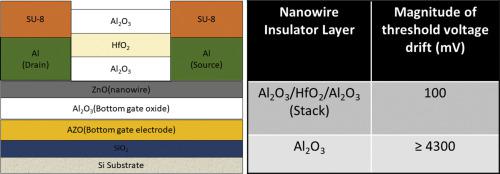当前位置:
X-MOL 学术
›
Microelectron. Eng.
›
论文详情
Our official English website, www.x-mol.net, welcomes your feedback! (Note: you will need to create a separate account there.)
Multi-stack insulator to minimise threshold voltage drift in ZnO FET sensors operating in ionic solutions
Microelectronic Engineering ( IF 2.3 ) Pub Date : 2020-05-01 , DOI: 10.1016/j.mee.2020.111348 J.D. Akrofi , M. Ebert , J.D. Reynolds , K. Sun , R. Hu , M.R.R. de Planque , H.M.H. Chong
Microelectronic Engineering ( IF 2.3 ) Pub Date : 2020-05-01 , DOI: 10.1016/j.mee.2020.111348 J.D. Akrofi , M. Ebert , J.D. Reynolds , K. Sun , R. Hu , M.R.R. de Planque , H.M.H. Chong

|
Abstract FET biosensors operating in an electrolyte experience a monotonic, temporal and relatively slow change in threshold voltage caused by the hydration of the insulator layer between the electrolyte and the FET's channel. Minimising this temporal change in threshold voltage is critical as, over time, the drain current of n-channel FETs decreases, making it difficult to distinguish between the signal generated in response to analyte - receptor binding events and the background noise generated by the electrolyte and the FET biosensor. While Rapid Thermal Annealing of the insulator layer is known to diminish threshold voltage drift and its negative effects, it is not compatible with a low temperature fabrication process of 200 °C. Our low temperature approach to minimising threshold voltage drift involves depositing a tri-layer insulator stack, consisting of a layer of HfO2 between two Al2O3 layers. Wetting ZnO NWFETs with PBS (10 mM phosphate, 150 mM KCl, pH 7.4) for an hour, showed that ZnO NWFETs with a stack insulator layer experienced a much smaller threshold voltage and drain current drift (100 mV, 0.064 nA) than ZnO NWFETs with a single material insulator layer (≥4300mV, 2.72 nA), Aluminium oxide in this case. Having established the resilience enhancing properties of the stack insulator layer on FETs operating in electrolytes of physiological relevant ionic concentrations; ZnO NWFETs with a stack insulator layer were shown to be capable of detecting the presence of the miDNA-21 strands. This, in effect, paves the way for miRNA sensing experiments in the near future and for exploring the potential of ZnO NWFETs as a diagnostic tool.
中文翻译:

多堆栈绝缘体可最大限度地减少在离子溶液中运行的 ZnO FET 传感器的阈值电压漂移
摘要 在电解质中运行的 FET 生物传感器会经历阈值电压的单调、时间和相对缓慢的变化,这是由电解质和 FET 通道之间的绝缘体层的水合作用引起的。最小化阈值电压的这种时间变化至关重要,因为随着时间的推移,n 沟道 FET 的漏极电流会降低,从而难以区分响应分析物 - 受体结合事件而产生的信号和电解质产生的背景噪声和FET 生物传感器。虽然已知绝缘体层的快速热退火可以减少阈值电压漂移及其负面影响,但它与 200 °C 的低温制造工艺不兼容。我们最小化阈值电压漂移的低温方法涉及沉积三层绝缘体堆叠,该堆叠由位于两个 Al2O3 层之间的 HfO2 层组成。用 PBS(10 mM 磷酸盐,150 mM KCl,pH 7.4)润湿 ZnO NWFET 一小时,表明具有堆叠绝缘层的 ZnO NWFET 的阈值电压和漏极电流漂移(100 mV,0.064 nA)比 ZnO NWFET 小得多在这种情况下,具有单一材料绝缘体层(≥4300mV,2.72 nA),氧化铝。已确定在生理相关离子浓度的电解质中运行的 FET 上的堆叠绝缘体层的弹性增强特性;具有堆叠绝缘层的 ZnO NWFET 被证明能够检测 miRNA-21 链的存在。这实际上,
更新日期:2020-05-01
中文翻译:

多堆栈绝缘体可最大限度地减少在离子溶液中运行的 ZnO FET 传感器的阈值电压漂移
摘要 在电解质中运行的 FET 生物传感器会经历阈值电压的单调、时间和相对缓慢的变化,这是由电解质和 FET 通道之间的绝缘体层的水合作用引起的。最小化阈值电压的这种时间变化至关重要,因为随着时间的推移,n 沟道 FET 的漏极电流会降低,从而难以区分响应分析物 - 受体结合事件而产生的信号和电解质产生的背景噪声和FET 生物传感器。虽然已知绝缘体层的快速热退火可以减少阈值电压漂移及其负面影响,但它与 200 °C 的低温制造工艺不兼容。我们最小化阈值电压漂移的低温方法涉及沉积三层绝缘体堆叠,该堆叠由位于两个 Al2O3 层之间的 HfO2 层组成。用 PBS(10 mM 磷酸盐,150 mM KCl,pH 7.4)润湿 ZnO NWFET 一小时,表明具有堆叠绝缘层的 ZnO NWFET 的阈值电压和漏极电流漂移(100 mV,0.064 nA)比 ZnO NWFET 小得多在这种情况下,具有单一材料绝缘体层(≥4300mV,2.72 nA),氧化铝。已确定在生理相关离子浓度的电解质中运行的 FET 上的堆叠绝缘体层的弹性增强特性;具有堆叠绝缘层的 ZnO NWFET 被证明能够检测 miRNA-21 链的存在。这实际上,


























 京公网安备 11010802027423号
京公网安备 11010802027423号